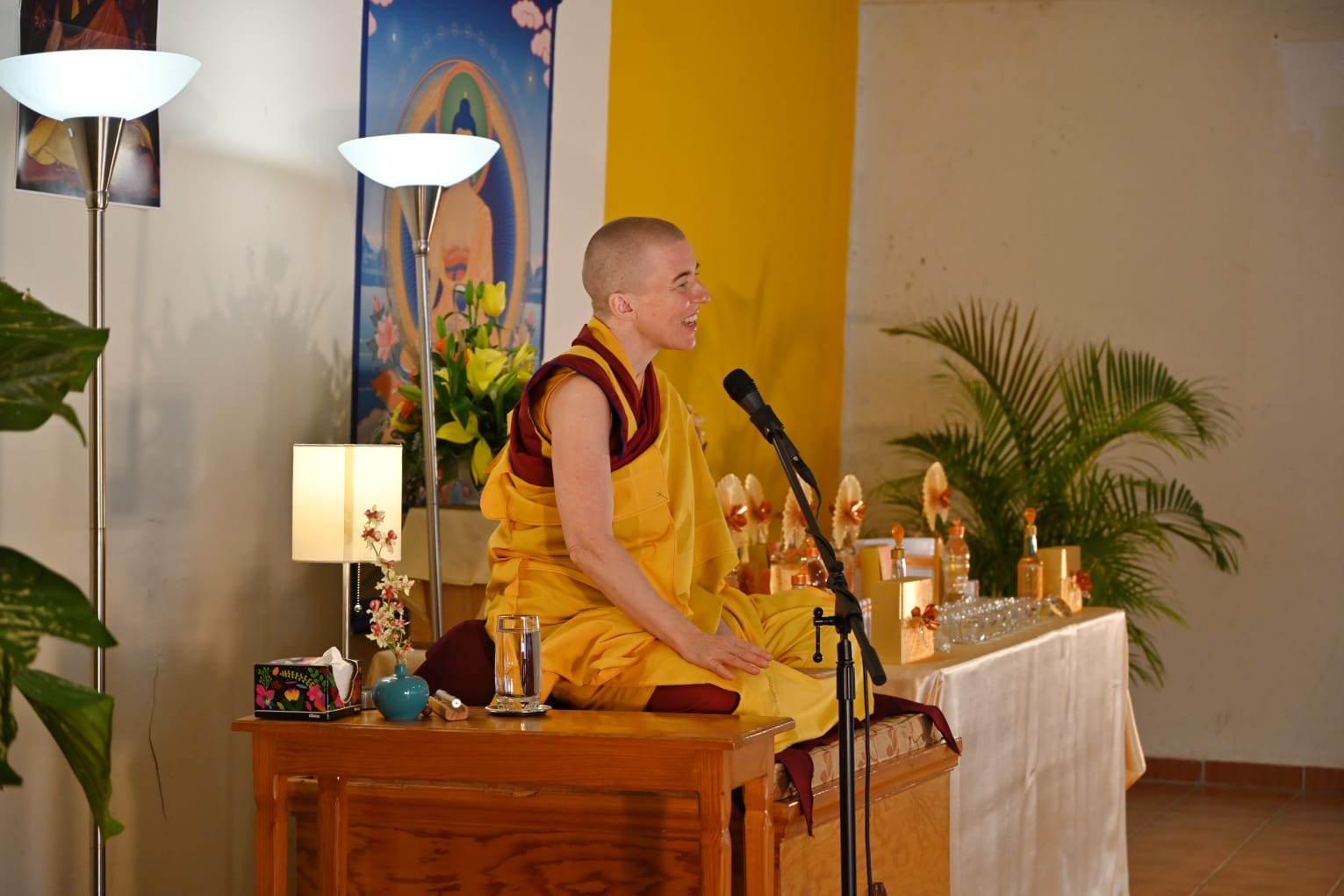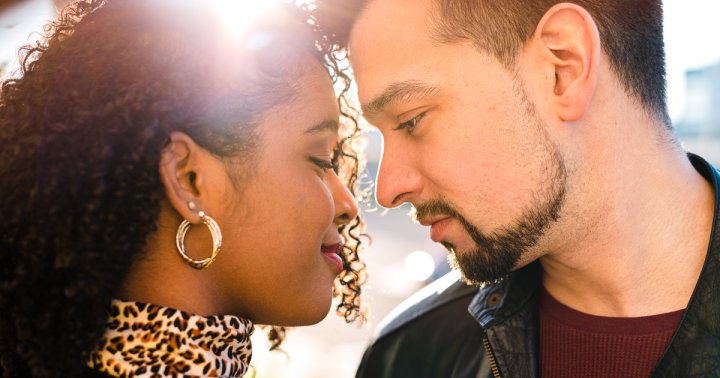Shabala King Garuda — Multicolored King of Air, Chi, Prajna — Cheng, Enlightened Lord of the Five Activities of the Buddha
King Garuda is magnificent chief among the Four Dignities in Buddhism, Enlightened protector of the North of the mandala, and the king of all bird beings and air beings. This makes him among the most important of Enlightened Deities...
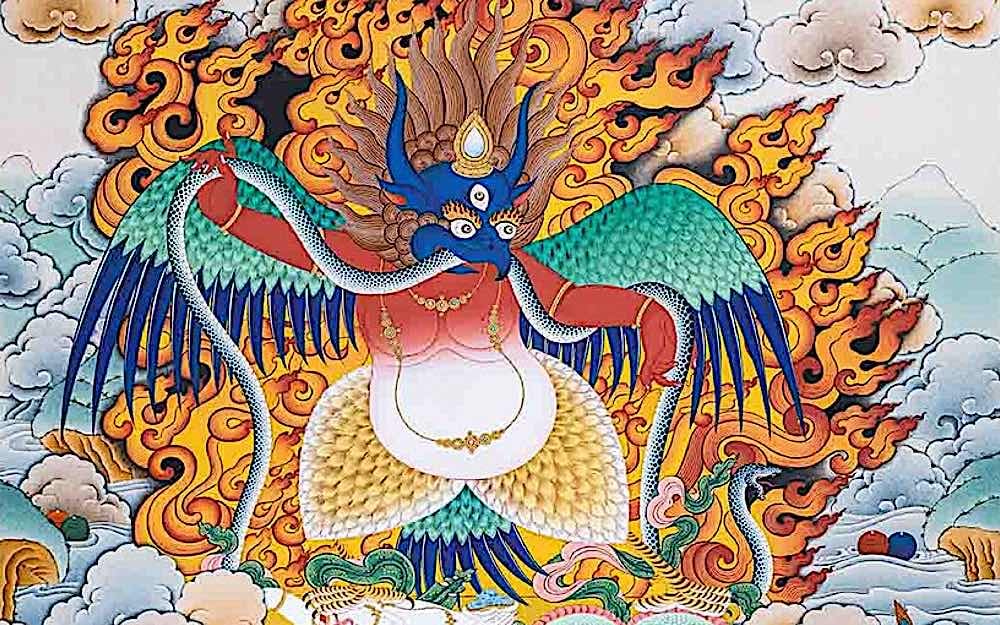
King Garuda is magnificent chief among the Four Dignities in Buddhism, Enlightened protector of the North of the mandala, and the king of all bird beings and air beings. This makes him among the most important of Enlightened Deities in Buddhism. As the wind-element protector, he is the patron of chi and prana and wind in our bodies. This is the very stuff of life.
For a short meditation/visualization with mantra, see later in this feature! Shabala King Multicolored Garuda is one of the 13 Golden Dharmas of the Sakya Lineage and is found in the Kalachakra literature. He body is all the colors of symbolic activities of the Buddhas: white for pacifying (Vairocahana Buddha family), Green wings for windy activities of Amoghasiddha/ Tara’s family, Red for the compassionate Lotus family of Amitabha Buddha, Blue for the spacious activity of Akshobya Buddha, and Yellow for the prosperity and auspiciousness earth activities of Amoghasiddhi’s Buddha Family.
Shabala King Multicolored Garuda is one of the 13 Golden Dharmas of the Sakya Lineage and is found in the Kalachakra literature. He body is all the colors of symbolic activities of the Buddhas: white for pacifying (Vairocahana Buddha family), Green wings for windy activities of Amoghasiddha/ Tara’s family, Red for the compassionate Lotus family of Amitabha Buddha, Blue for the spacious activity of Akshobya Buddha, and Yellow for the prosperity and auspiciousness earth activities of Amoghasiddhi’s Buddha Family.King Garuda and Martial Arts
In martial arts movies, you often see martial artists performing extraordinary, almost super human skills, such as lightness skills, or super strength, or walking across the water, or from tree top to tree top. You might see a monk whirl into action and leave twelve stunned attackers on the ground. How is this conceptualized? This is a perhaps slightly exaggerated, but fun portrayal of the power of chi (“lung in Tibetan” or prana, or wind. Martial artists channel this chi for power.
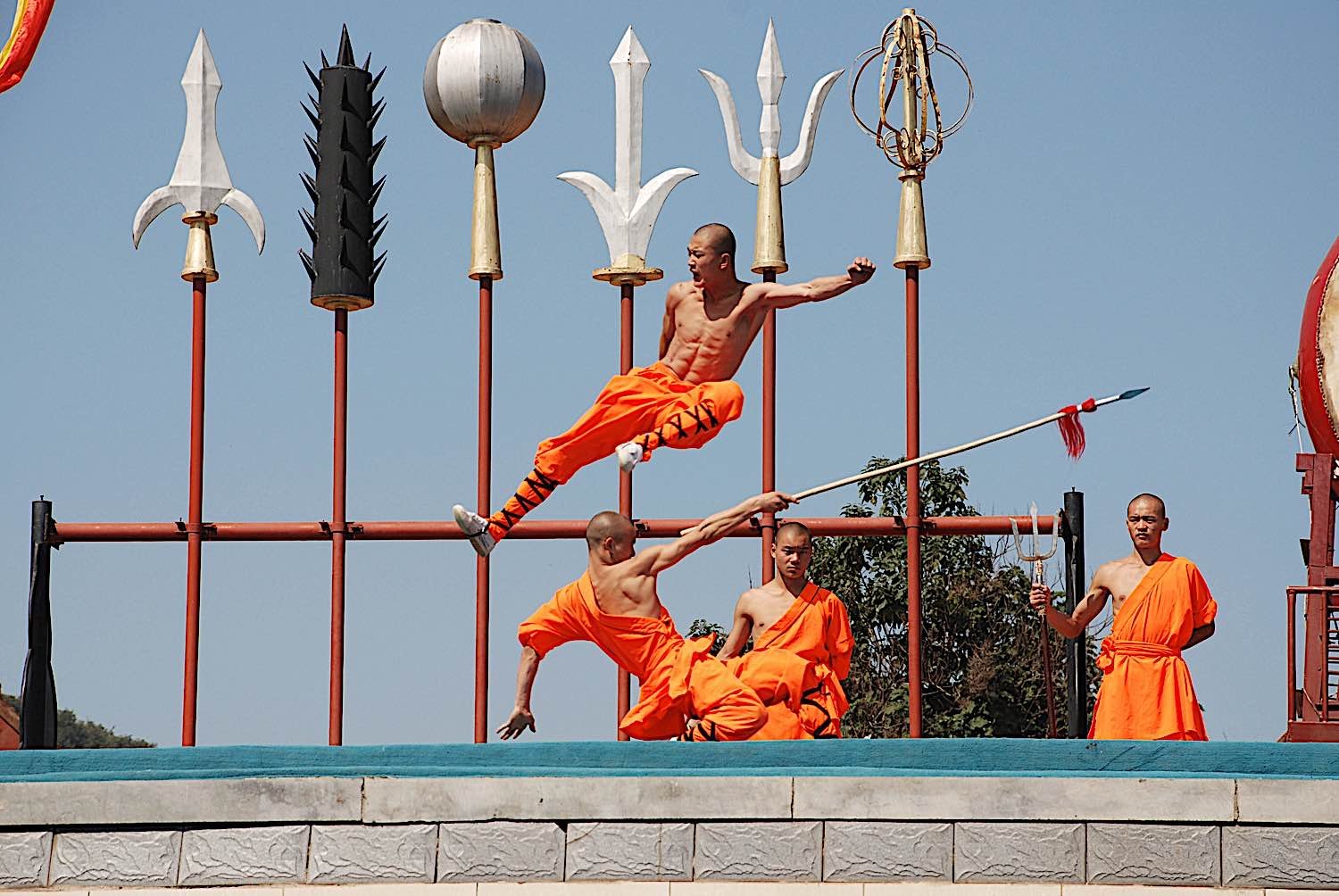 Bodhidharma is also the legendary founder of Kungfu in Shaolin, a method of both exercise for monks and self-defence. Today, Shaolin is worldfamous and demonstrates kungfu around the world This demonstration is at the Shaolin temple. Martial arts as practiced here help refine, cultivate and develop wind or chi or prana, which is associated with King Garuda, Tara and Amoghasiddhi.
Bodhidharma is also the legendary founder of Kungfu in Shaolin, a method of both exercise for monks and self-defence. Today, Shaolin is worldfamous and demonstrates kungfu around the world This demonstration is at the Shaolin temple. Martial arts as practiced here help refine, cultivate and develop wind or chi or prana, which is associated with King Garuda, Tara and Amoghasiddhi.
It is this concept that powers the practice of great Lord Garuda, the Dignity of the Air and Wind, and the power behind that mysterious chi or prana.
Garuda’s best known form is Shabala Multicolored Garuda, a five-colored form to show that he encompasses all the Enlightened Activities of all five Buddha Families: white for pacifying, blue for wrathful, red for magnetizing, yellow for auspiciousness, and green for all activities.
 All Five of the Garuda colors as Five surrounding Garudas of the mandala of Shabala Garuda. Shabala Garuda is in the center of the Mandala and contains all the colors and activities. Surrounding him are White Buddha Garuda, Blue Vajra Garuda, Green Karma Garuda, Yellow Ratna Garuda and Red Padma Garuda. (In visualization, the white Buddha Garuda usually is visualized at the heart of Shabala Garuda, since Buddha Garuda is the center color.). Tangka courtesy of TangkaNepal. The Tangka is available here>>
All Five of the Garuda colors as Five surrounding Garudas of the mandala of Shabala Garuda. Shabala Garuda is in the center of the Mandala and contains all the colors and activities. Surrounding him are White Buddha Garuda, Blue Vajra Garuda, Green Karma Garuda, Yellow Ratna Garuda and Red Padma Garuda. (In visualization, the white Buddha Garuda usually is visualized at the heart of Shabala Garuda, since Buddha Garuda is the center color.). Tangka courtesy of TangkaNepal. The Tangka is available here>>
He rules a mandala of five Garudas, with himself pictured in the center, and surrounding him are
Buddha Garuda, in the center who is white (he is visualized at Shabala Garuda’s heart chakra, since Shabala is occupying the center of the mandala) representing pacifying activities of the Vairochana Buddha Family Vajra Garuda, in the East, who is blue representing wrathful and healing activities of the Akshobya Buddha Family and Medicine Buddha Ratna Garuda, in the South, who is yellow, representing accumulating and auspiciousness activities of the Ratnasambhava’s Jewel Family Padma Garuda, in the West, who is red, representing magnetizing and enchanting compassionate activities of the Amitabha Buddha Family Karma Garuda, in the North, who is green, representing all the activities of Amoghasiddhi and Green Tara’s Karma Family — green symbolically represents all activities, or the blending of all colors. Shabala King Garuda, standing on the symbolic enemy, the Naga who are the cause of disease. King Garuda also has a naga in his sharp eagle-like mouth. Shabala Garuda contains all five colors of the five wisdom Buddha Families, indicating he represents all five activities of Enlightenment: pacifying, enchanting or magnetizing, wrathful, auspiciousness and accumulation, and green for all activities. Image: Himalayan Art.
Shabala King Garuda, standing on the symbolic enemy, the Naga who are the cause of disease. King Garuda also has a naga in his sharp eagle-like mouth. Shabala Garuda contains all five colors of the five wisdom Buddha Families, indicating he represents all five activities of Enlightenment: pacifying, enchanting or magnetizing, wrathful, auspiciousness and accumulation, and green for all activities. Image: Himalayan Art.
He is always active, flying, swooping, watching. As the wind of the north, he is a virtual hurricane of fearless energy.
Different forms of King Garuda
As with all Enlightened Deities, he can appear and manifest in any form or color. His forms are numerous, but his best known, aside from Shabala Multicolored Garuda, are probably Black Garuda and crowning the Three Fierce Ones: Vajrapani Hayagriva Garuda.
 King Garuda, the activity of the Buddhas is often depicted swooping, diving, or in action against all that afflicts us, here symbolized by the naga in his mouth. As the traditional antagonist of Nagas, he is associated with healing and life’s breath Chi, Wind, “Lung” in Tibetan, or Prana.
King Garuda, the activity of the Buddhas is often depicted swooping, diving, or in action against all that afflicts us, here symbolized by the naga in his mouth. As the traditional antagonist of Nagas, he is associated with healing and life’s breath Chi, Wind, “Lung” in Tibetan, or Prana.
Padmasambhava, Guru Rinpoche, an Enlightened Buddha also manifested as King Garuda in one lineage teaching. Meanwhile, Black Garuda is actually an emanation of Shakyamuni Buddha, manifesting with this appearance to subdue disease and nagas.
 Black Garuda is a special healing practice lineage.
Black Garuda is a special healing practice lineage.Three Fierce Ones: Vajrapani Hayagriva King Garuda
In another lineage, the pre-eminent healing practice is the combined “three fierce ones” who are King Garuda, Vajrapani and Hayagriva. His mantra is
Om Vajrapani Hayagriva Garuda Hum Phet
This mantra is famous for healing. Often, healing activities are thought of as wrathful, since to fight a disease requires focus, power and strength.
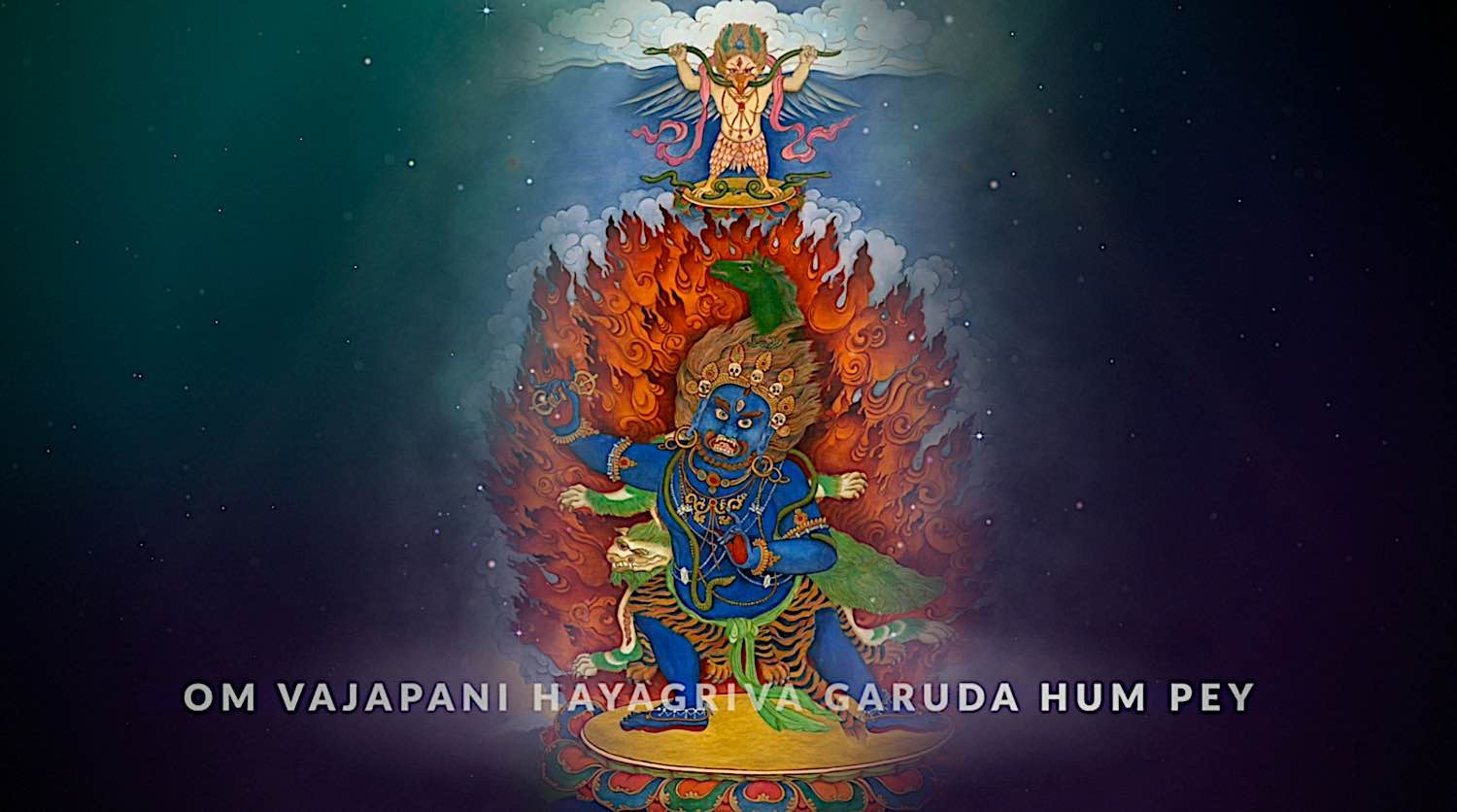 The Three Fierce Healing Ones Vajrapani Hayagriva King Garuda vizualized together with a special mantra Om Vajrapani Hayagriva Garuda Hum Pey . Rinpoche describes how to visualize the Three Powerful Healing Buddhas together and chant their mantra for healing.
The Three Fierce Healing Ones Vajrapani Hayagriva King Garuda vizualized together with a special mantra Om Vajrapani Hayagriva Garuda Hum Pey . Rinpoche describes how to visualize the Three Powerful Healing Buddhas together and chant their mantra for healing.Hayagriva, who is represented in this mandala by the green horse head — Hayagriva translates as “horse head” Buddha, a manifestation of Amitabha and Avalokiteshvara — is likewise associated with Wind and Chi and martial arts in a way similar to King Garuda. The green horse head arising from his main head is “wind horse” or Chi, the power of life.
For a feature on Vajrapani Hayagriva Garuda, see>> For a feature on Amtitabha’s wrathful heruka manifestation Hayagriva, see our full feature>> For a video on Hayagriva, a full documentary, see>> For Hayagriva’s powerful chanted mantra, needed in these “troubled times” see>>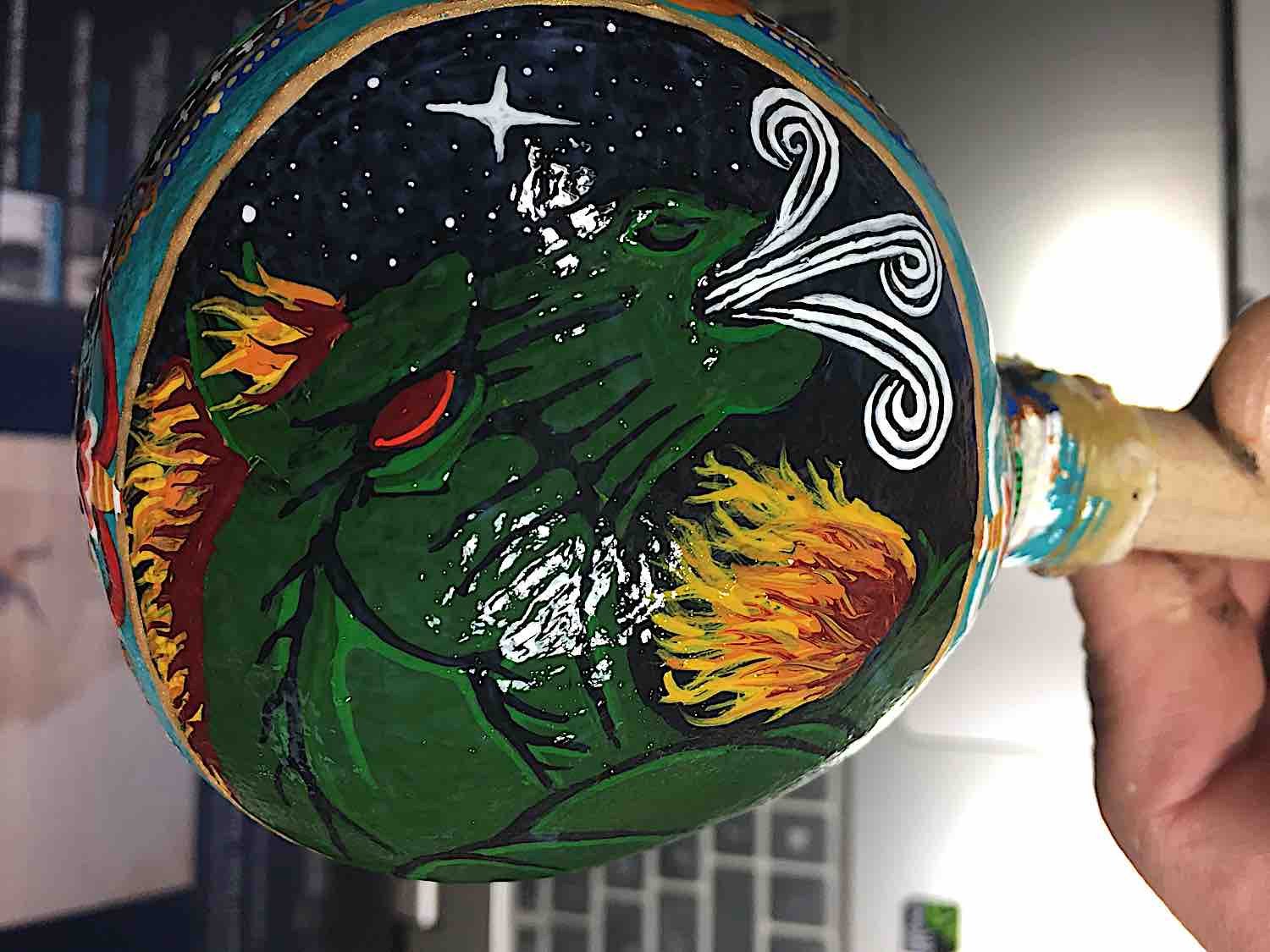 Hayagriva’s green horse. Close up detail of a Dharma rattle created by artist Sean Wah with a detail of the windhorse on Hayagriva’s head. Note the sparks and flames of the mane, which symbolize his power. The horse head (or heads) emerge from Hayagriva’s heads. Hayagriva has three heads/faces (in most visualizations), representing the Three Doors: Body, Speech, Mind. As explained by Ven. Lama Jigme Rinpoche: “The horse’s manes are red symbolizing that it is there to give help; neighing with opened mouth, it conquers the three realms and terrifies evil spirits. “
Hayagriva’s green horse. Close up detail of a Dharma rattle created by artist Sean Wah with a detail of the windhorse on Hayagriva’s head. Note the sparks and flames of the mane, which symbolize his power. The horse head (or heads) emerge from Hayagriva’s heads. Hayagriva has three heads/faces (in most visualizations), representing the Three Doors: Body, Speech, Mind. As explained by Ven. Lama Jigme Rinpoche: “The horse’s manes are red symbolizing that it is there to give help; neighing with opened mouth, it conquers the three realms and terrifies evil spirits. “The combination of the three, the powerful Vajrapani, Hayagriva (as the wrathful Amitabha) and King Garuda, make the combine practice a powerful healing modality.
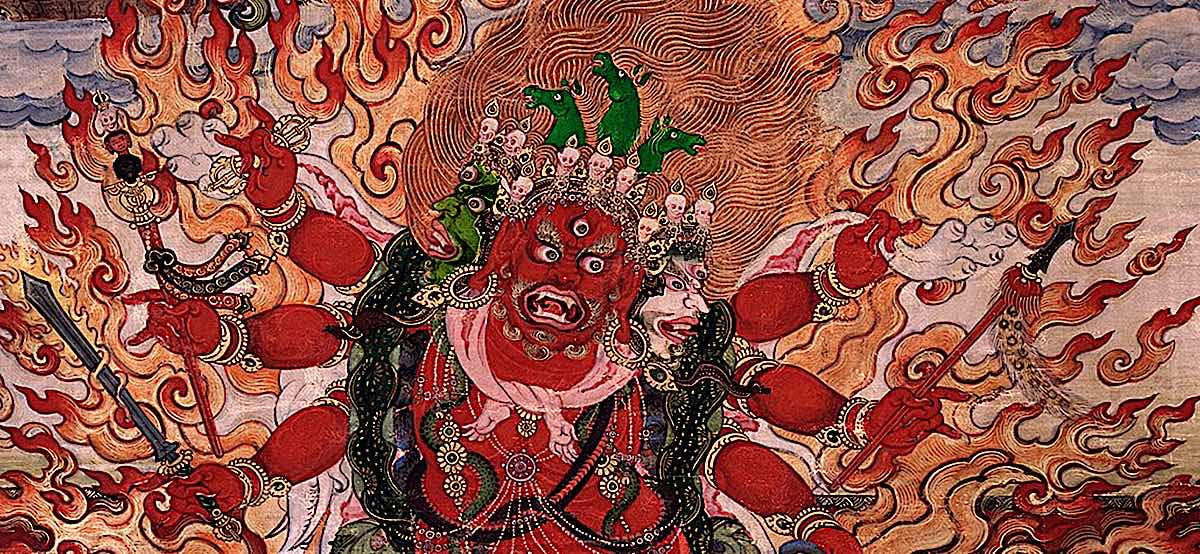 Hayagriva Sandrup closeup with three green horse heads (representing wind horse and chi) and three faces red centre, green right and white left with six arms, supreme Heruka of the Amitabha Family. The green face and the three green horse heads indicate his supreme power over Chi, or Lung or Prana, the very stuff of life. For a feature on Hayagriva, see>>
Hayagriva Sandrup closeup with three green horse heads (representing wind horse and chi) and three faces red centre, green right and white left with six arms, supreme Heruka of the Amitabha Family. The green face and the three green horse heads indicate his supreme power over Chi, or Lung or Prana, the very stuff of life. For a feature on Hayagriva, see>>King Garuda in Hinduism is also the sacred companion and mount of Vishnu. Garuda is venerated in Buddhism, Hinduism and Jainism. Garuda is also a race of beings, like nagas, mentioned in several sutras.
 Famous statue of great Vishnu riding on the wings of Garuda.
Famous statue of great Vishnu riding on the wings of Garuda.
Garuda — King of the Four Dignities
Garuda is also the leader among the four dignities of the four directions, who include: Enchanting Dragon in the west, invulnerable Snow lion in the east and fierce Tiger in the South and King Garuda in the north, who commands the greatest respect.
Garuda is the “strong arm” and activity of the Buddhas, the one who removes fear and fights our enemies.
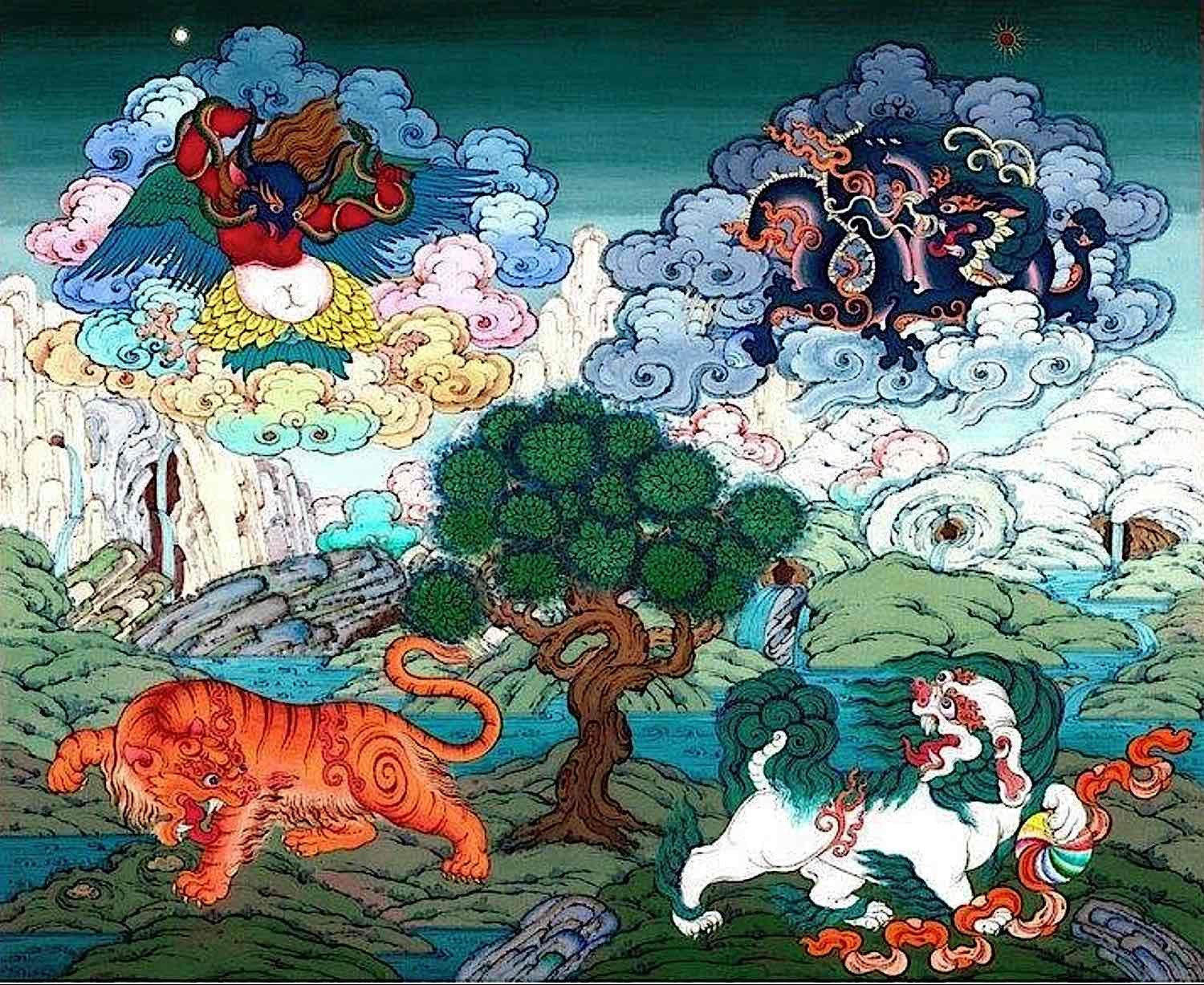 The Four Dignities in Tibetan Buddhism and the auspicious animals of Bhutan: Cheng (Garuda) upper left, Tak (Tiger) lower left Seng (Snow Lion) lower right, and Druk (Dragon) upper right. These are four directional guardians with Garuda in the north, Snow Lion in the east, Tiger in the south and Dragon in the West. (In some regions or lineages of Buddhism the directions may be changed).
The Four Dignities in Tibetan Buddhism and the auspicious animals of Bhutan: Cheng (Garuda) upper left, Tak (Tiger) lower left Seng (Snow Lion) lower right, and Druk (Dragon) upper right. These are four directional guardians with Garuda in the north, Snow Lion in the east, Tiger in the south and Dragon in the West. (In some regions or lineages of Buddhism the directions may be changed).
Where Dragon represents generosity and achievement, and Snow Lion represents vitality and purity, and Tiger displays confidence and discipline, King Garuda stands as the champion of fearlessness, and the power of wisdom to overcome dangers and fears. He is the strong protective agent of Mother Tara. (See our special section on Mother Tara>>)
These four great dignities are not just charming stories or myth, with symbolic meanings. They embody the four elements that make our world: air or wind, fire, water, and earth, represented respectively by Garuda for air, Dragon for fire, Snow Lion for water and Tiger for Earth.
For a feature on the Four Dignities, see our full feature>> Four Dignities or Deities of the Directions Tak (Tiger) Seng (Snow Lion) Chung (Garuda) and Druk (Dragon). They often appear on prayer flags, especially Garuda, as the element of air, or alternately Wind Horse.
Four Dignities or Deities of the Directions Tak (Tiger) Seng (Snow Lion) Chung (Garuda) and Druk (Dragon). They often appear on prayer flags, especially Garuda, as the element of air, or alternately Wind Horse.
Elemental Powers — Air and Chi Empower Life Itself
Their powers and aspects manifest in our world in very real terms. The wind and air brings us life, through our breath and chi. Externally, wind brings in the rain for the crops, cools off the heatwaves. Both external and internal forces are symbolized by King Garuda.
Even if you don’t think of King Garuda as a being, he is a force we live with every day. Whether we respect that force is up to us. Making offerings to King Garuda is the same as honouring the vital essence of air and wind in our world, that gives us life.
 The popular empowering Garuda Mudra. With the right hand on top of the left, in front of our heart (palms facing our heart) we display the “wings of Garuda” by hooking our two thumbs and “splaying” out our fingers like feathers. This is a popular Yoga mudra, as it represents the channels of the body and the wind prana or chi in the body. The heart chakra
The popular empowering Garuda Mudra. With the right hand on top of the left, in front of our heart (palms facing our heart) we display the “wings of Garuda” by hooking our two thumbs and “splaying” out our fingers like feathers. This is a popular Yoga mudra, as it represents the channels of the body and the wind prana or chi in the body. The heart chakra Notice how the mudra with the hands above resemble the wings of the Garuda.
Notice how the mudra with the hands above resemble the wings of the Garuda.When we want to invoke his vitalizing air or chi or prana, and his protection, we might display his mudra and chant his mantra. His mudra is well-known to Yogis as the Garuda Mudra, and helps yogis and yoginis to balance their vital energies and wind — balancing the yin and the yang and the left and the right.
 A simplified view of the chakra system of the inner body as visualized in Vajrayana Buddhism. The heart chakra has eight channels. When visualizing Garuda healing, we display the Garuda mudra, with eight fingers splayed out to represent the heart chakra. Healing energy and light is visualized entering the heart chakra and distributing out through the eight channels to every channel and chakra in our body.
A simplified view of the chakra system of the inner body as visualized in Vajrayana Buddhism. The heart chakra has eight channels. When visualizing Garuda healing, we display the Garuda mudra, with eight fingers splayed out to represent the heart chakra. Healing energy and light is visualized entering the heart chakra and distributing out through the eight channels to every channel and chakra in our body.
We hold our hands in front of our heart, the right hand on top of the left hand, with the right thumb hooking around the knuckle of the other thumb. This symbolizes the charka channels, which internally unite at the central channel at our heart chakra. Our two hands are displayed like wings of a Garuda, with the fingers splayed to represent the channels branching out.
 The eight channels of the heart chakra (viewed cross section from above) illustrated by the amazing Jampay Dorje (Ben Christian). Visit his art website here>> The Eight channels of the heart, which connect to all channels of the inner body, are represented in the Garuda hand mudra by the eight fingers splayed out.
The eight channels of the heart chakra (viewed cross section from above) illustrated by the amazing Jampay Dorje (Ben Christian). Visit his art website here>> The Eight channels of the heart, which connect to all channels of the inner body, are represented in the Garuda hand mudra by the eight fingers splayed out.
Shabala Multi-Colored Garuda Visualization
The best known practice of Garuda is probably the five-activity Shabala Transcendental Wisdom Multi-Colored Garuda — which originates both from Kalachakra literature, and is one of the thirteen golden dharma practices of Sakya. These thirteen golden Dharmas are the most important in the lineage.
 Shabala Multicolored Garuda in a very old tangkha from Himalaya Art. Surrounding the Multicolored Shabala Garuda are the five Garudas of the five families: Buddha Garuda, Vajra Garuda, Ratna Garuda, Padma Garuda and Karma Garuda.
Shabala Multicolored Garuda in a very old tangkha from Himalaya Art. Surrounding the Multicolored Shabala Garuda are the five Garudas of the five families: Buddha Garuda, Vajra Garuda, Ratna Garuda, Padma Garuda and Karma Garuda.
If you do not have empowerment, you can still practice by visualizing the Buddha as Shabala Multi Colored Garuda in front of you. Always start, as with all Buddhist practices, with Taking Refuge in the Buddha, the Dharma and the Sangha and stating Bodhichitta aspiration. This can be as simple as saying three times:
I take refuge in the Buddha the Dharma and the Sangha until I attain Enlightenment, for the benefit of all sentient beings.
Make the sensory offerings: candle, incense, water, some food. This can be as simple as lighting a candle, an incense stick, placing a flower and an apple. Since Garuda is an activity deity, and a wisdom protector, it is good to offer hot tea.
 Shabala Garuda. His head is blue, his upper body red, his torso white, his lower body yellow and his glorious wings are shimmering green. He is surrounded by wisdom flames and stands on nagas. He holds a Naga in his fierce mouth. Himalaya Art.
Shabala Garuda. His head is blue, his upper body red, his torso white, his lower body yellow and his glorious wings are shimmering green. He is surrounded by wisdom flames and stands on nagas. He holds a Naga in his fierce mouth. Himalaya Art.
In front of you, visualize one-faced two armed and three eyed Garuda. The multicolored Shabala Garuda has a blue head. His shoulders and crown are multicolored, in the nature of luminous space. His upper body is red, in the nature of fire and tummo, and his belly is white in the nature of water. His legs are golden, in the nature of earth.
He has vast wings that are luminous and lusterous greens like multicolored windy clouds for activity. His right hand is in the mudra of granting refuge in the three Jewels and his left hand is in the threatening mudra to threaten the nagas and spirits. He is devouring the King of Nagas, in his sharp eagle-like beak, and standing on Nagas on lotus and sun disc. He is surrounded by wisdom flames.
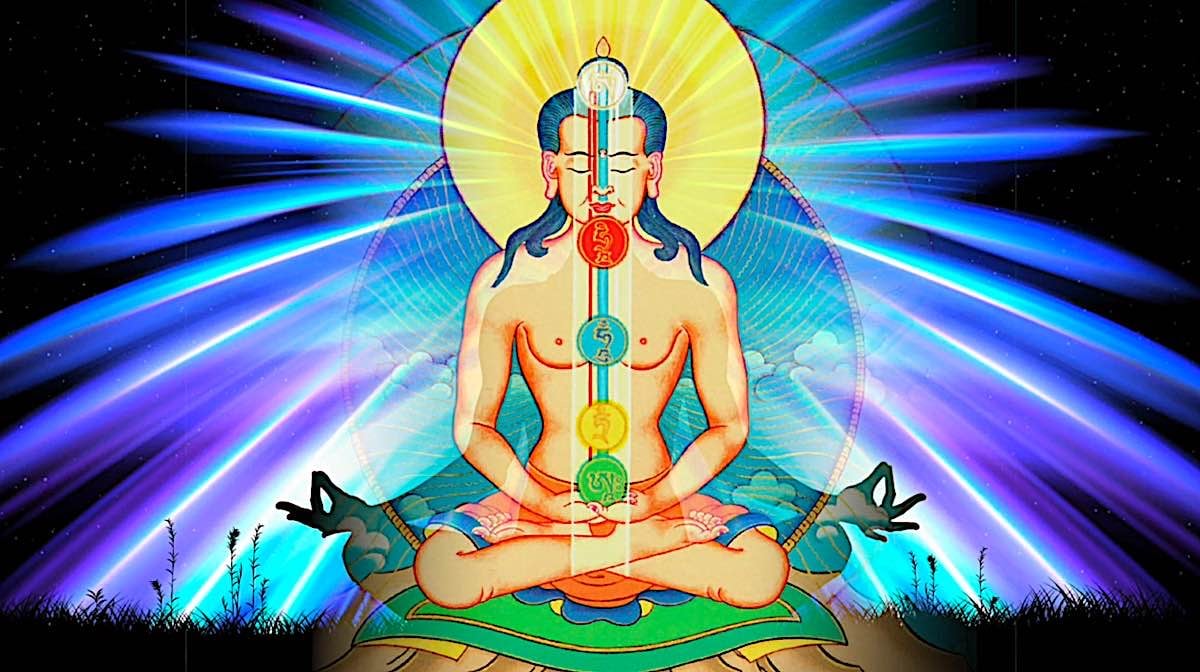 In Tibetan Buddhist practice, mandalas are both external and internal. The internal mandalas are placed on the primary charkas of the body. the Five Buddha Families are placed at five primary chakras with White MahaVairochana’s Buddha family at the crown chakra on top of the head, Red Amitabha’s Padma (Lotus) Family at the throat chakra representing Dharma Speech, Blue Akshobya’s Vajra family at the heart representing Enlightened Mind, Yellow Ratnasambhava’s Jewel family at the navel chakra, and Green Amoghasiddhi and Tara’s Karma family at the chakra where Chi or Prana or wind (“lung”) gathers, called the Secret Chakra (one spread below the navel). If you can visualize it, you visualize the five empowering and healing lights (white, red, blue, yellow, green) absorbing into these five chakras.
In Tibetan Buddhist practice, mandalas are both external and internal. The internal mandalas are placed on the primary charkas of the body. the Five Buddha Families are placed at five primary chakras with White MahaVairochana’s Buddha family at the crown chakra on top of the head, Red Amitabha’s Padma (Lotus) Family at the throat chakra representing Dharma Speech, Blue Akshobya’s Vajra family at the heart representing Enlightened Mind, Yellow Ratnasambhava’s Jewel family at the navel chakra, and Green Amoghasiddhi and Tara’s Karma family at the chakra where Chi or Prana or wind (“lung”) gathers, called the Secret Chakra (one spread below the navel). If you can visualize it, you visualize the five empowering and healing lights (white, red, blue, yellow, green) absorbing into these five chakras.
Visualizing Empowering and Healing Light
Now, visualize lights streaming from Garuda’s body into your body, healing, empowering, auspicious, purifying, powerful light. If you are able, you visualize the five Garudas around Shabala Garuda, with White Garuda at his heart chakra, and Blue, Yellow, Red and Green Garudas surrounding him in the four cardinal directions. Otherwise, you visualize the light emanating from main Shabala Garuda, who is every color. If you viusualize this way, try to visualize the white light absorbing into your crown, the red to your throat chakra, the blue to the heart chakra, the yellow at the navel chakra, and the green at the secret chakra (see image above.)
 As you visualize, hold your hands in front of your heart in the Garuda Mudra.
As you visualize, hold your hands in front of your heart in the Garuda Mudra.
White, red, blue, green and yellow light emanate and radiate from Shabala Garuda and absorb into your own body’s five chakras.
White Buddha Garuda’s pacifying light absorbs into our crown chakra, purifying our entire body of all defilements.
Red Padma Garuda’s magnetizing light absorbs into our throat chakra, blessing our speech.
Blue Vajra Garuda’s healing light absorbs into our heart chakra, purifying our mind streams.
Yellow Ratna Garuda’s light absorbs into our navel chakra, purifying all negative karma and bringing auspiciousness.
Green Karma Garuda’s light absorbs into our secret chakra (below our navels), purifying all negative actions and removing our obstacles.
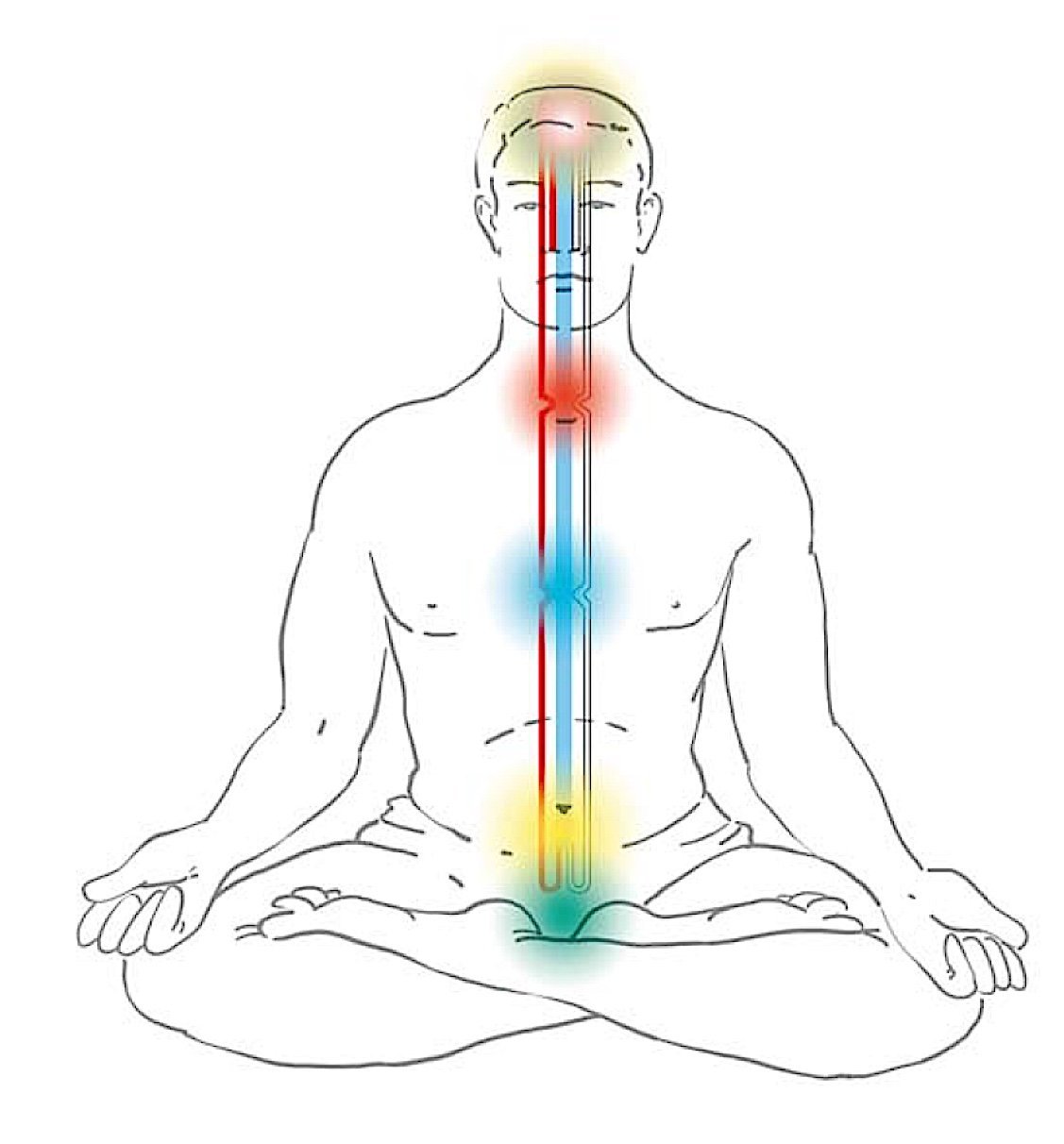 In Tibetan Tantric Buddhism, five chakras are visualized as the connecting points of the three channels: central, left and right. The Crown chakra is white, the throat red, the heart blue, the navel yellow and the secret chakra green.
In Tibetan Tantric Buddhism, five chakras are visualized as the connecting points of the three channels: central, left and right. The Crown chakra is white, the throat red, the heart blue, the navel yellow and the secret chakra green.
Shabala Garuda Mantra
As you visualize this, holding the image for as long as you can, and maintaing the Garuda mudra in front of your heart, chant or say or whisper the mantra as much as you can, or at least 21 or 108 times.
OM PAK SHIM SVA HA
Alternately, if you are using a mala to count your mantras, you can begin the first mantra with the Garuda mantra, but then pick up your mala for counting the rest.
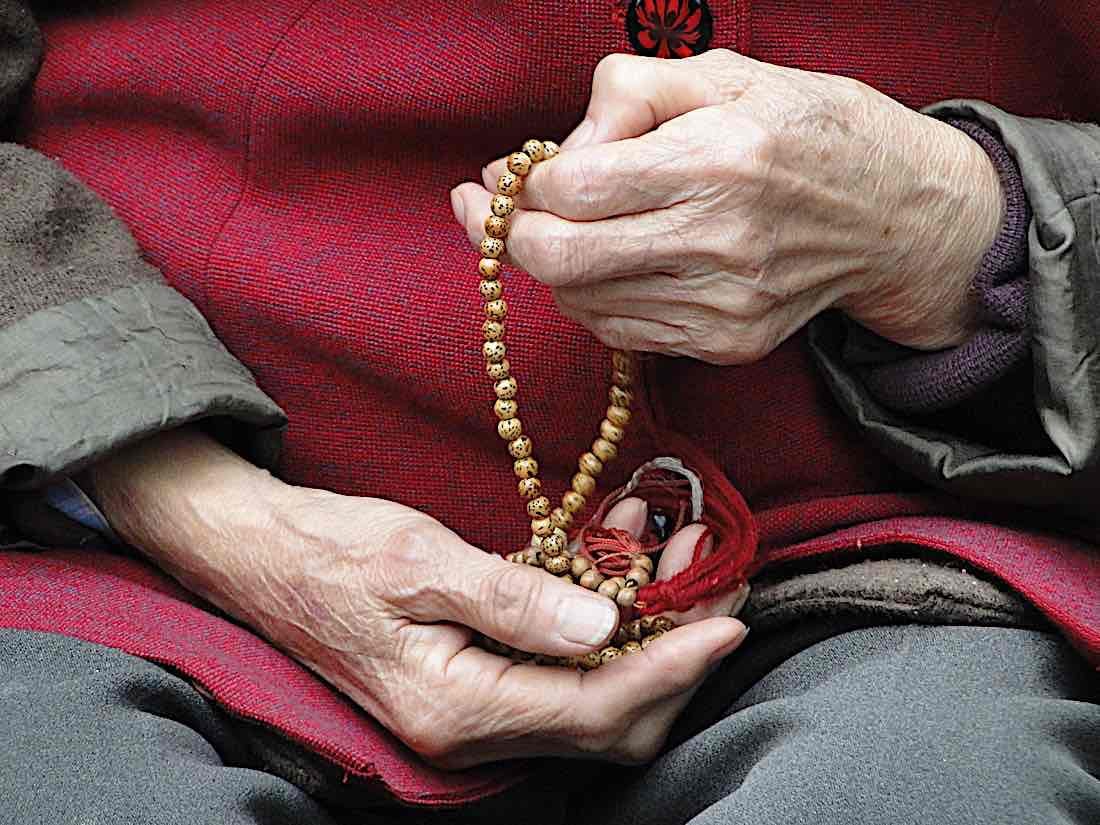 Repeated mantra recitation is a form of concentration and mindfulness.
Repeated mantra recitation is a form of concentration and mindfulness.
Dedicating the Merit
When you are finished your healing and empowering mantra visualization, it is important to dedicate the merit to the benefit of all sentient beings. This can be as simple as saying, three times:
I dedicate the merit of this practice to the cause for Enlightenment for the benefit of all sentient beings.
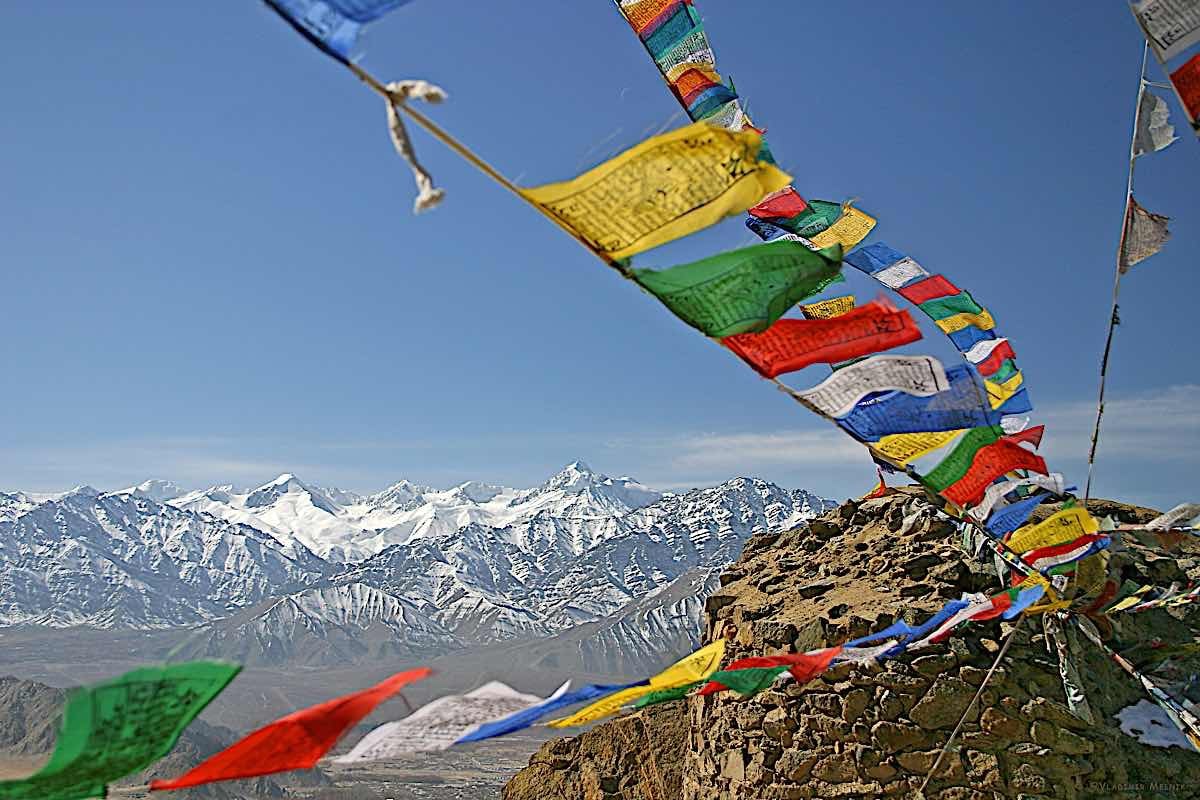 Prayer flags are ubiquitous in the Himalayas. Printed on them are usually a windhorse, surrounded by the four auspicious ones — Garuda, Dragon, Tiger, Snow Lion — with prayers and mantras. The wind carries the blessing to world. Wind is representative of the World’s Chi or the Prana of the Universe, which on a micro level we emulate with our own inner body.
Prayer flags are ubiquitous in the Himalayas. Printed on them are usually a windhorse, surrounded by the four auspicious ones — Garuda, Dragon, Tiger, Snow Lion — with prayers and mantras. The wind carries the blessing to world. Wind is representative of the World’s Chi or the Prana of the Universe, which on a micro level we emulate with our own inner body.
Chi, Wind and the Inner Body
One reason Garuda is so well loved in Buddhist practice, is his association with the “wind element.” Most healers in Buddhism work with the inner body, the chakras, and the breath or chi (pronoucned chee), in the same way as advanced martial artists work with the same winds. Yoga practices in Buddhism usually involve inner body work, and working with the chi, “lung” or prana of the body.
 Hayagriva’s green horse. Close up detail of a Dharma rattle created by artist Sean Wah with a detail of the windhorse on Hayagriva’s head. Note the sparks and flames of the mane, which symbolize his power. The horse head (or heads) emerge from Hayagriva’s heads. Hayagriva has three heads/faces (in most visualizations), representing the Three Doors: Body, Speech, Mind. As explained by Ven. Lama Jigme Rinpoche: “The horse’s manes are red symbolizing that it is there to give help; neighing with opened mouth, it conquers the three realms and terrifies evil spirits. “
Hayagriva’s green horse. Close up detail of a Dharma rattle created by artist Sean Wah with a detail of the windhorse on Hayagriva’s head. Note the sparks and flames of the mane, which symbolize his power. The horse head (or heads) emerge from Hayagriva’s heads. Hayagriva has three heads/faces (in most visualizations), representing the Three Doors: Body, Speech, Mind. As explained by Ven. Lama Jigme Rinpoche: “The horse’s manes are red symbolizing that it is there to give help; neighing with opened mouth, it conquers the three realms and terrifies evil spirits. “Garuda represents the awesome power of air, wind and activity, and is the powerful general in the spiritual army of Mother Tara and Amoghasiddhi Buddha in the North. His vast wings can create hurricane forces of wind directed against evil, enemies, opponents of the Dharma, disease and decay.
 Multicolored Garuda.
Multicolored Garuda.
Although all four dignities are mentioned in many sutras, Garuda is a frequent and awe-inspiring presence. Garudas are the powerful antagonist of Nagas or snakes and snake beings, and Kind Garuda rules all the Garudas, and all beings of the air and air realms.
Garudas are not just popular in Bhutan and Tibet, but in India, Nepal, Indonesia, Mongolia, and Thailand, and decorate many temples, and even businesses and homes.
 Garuda on a temple decoration, protecting the sacred space.
Garuda on a temple decoration, protecting the sacred space.
13 Golden Dharmas of the Sakya
Shabala Garuda is one of the 13 Dharmas of the Sakya lineage [4].
“The Thirteen Golden Dharmas (Tib.: ser cho chu sum) of the Sakya Tradition of Tibetan Buddhism are a group of special meditational practices so named because Sachen Kunga Nyingpo was required to offer gold to the teacher in requesting the initiation and teachings. The thirteen different teachings do not all come from the same teacher but rather several such as Bari Lotsawa, Mal Lotsawa and Nyen Lotsawa…
 Garuda Mudra.
Garuda Mudra.The Three Red Ones (mar mo kor sum) are all forms of Vajrayogini and are primarily used as meditational deities with the goal of realization. (1) Vajrayogini of Naropa, (2) Vajrayogini of Indrabhuti and (3) Vajrayogini of Maitripa – all from the Chakrasamvara cycle of Tantras.
The Three Great Red Ones (mar po kor sum) are power deities and used in subjugation or the rapid acquisition of material goods and wealth. (4) Kurukulla of the Hevajra Tantra, (5) Takkiraja of the Guhyasamaja Tantra and (6) Maharakta Ganapati associated with the Chakrasamvara Tantra (see Maharakta Outline Page).
The Three Small Red Ones (mar chung kor sum) are also power deities and used for acquiring specific material results. (7) Kurukulla-Tara of the Vajrapanjara Tantra, (8) Red Vasudhara of the Chakrasamvara cycle of Tantras and (9) Tinuma, the activity form of Vajravarahi, also of the Chakrasamvara cycle.

The four standard remaining deities which are common to most Sakya tradition groupings of the Thirteen Golden Dharmas are employed for a variety of sickness and disease. Red Jambhala is the exception and he is employed as a wealth deity. (10) Black Manjushri, (11) Shabala Garuda from the Kalachakra Tantra, (12) Simhanada Avalokiteshvara from its own tantra and (13) Red Jambhala from the Chakrasamvara Tantra.”
—Quote from the experts at Himalayan Art [4]
Glossary
Definition of Garuda on 84000 glossary of terms (from 84000 translation project>>)
nam mkha’ lding
mkha’ lding khyung gser ’dab nam mkha’i lding garuḍa suparṇa TermIn Indian mythology, the garuḍa is an eagle-like bird that is regarded as the king of all birds, normally depicted with a sharp, owl-like beak, often holding a snake, and with large and powerful wings. They are traditionally enemies of the nāgas. In the Vedas, they are said to have brought nectar from the heavens to earth. Garuḍa can also be used as a proper name for a king of such creatures.
Notes and Citations
[1] Credits: 5 Garudas images Tangka Nepal>>
[2] Buddhist Door: Riding on the Back of Freedom: The Meaning of the Garuda>>

 Koichiko
Koichiko 










